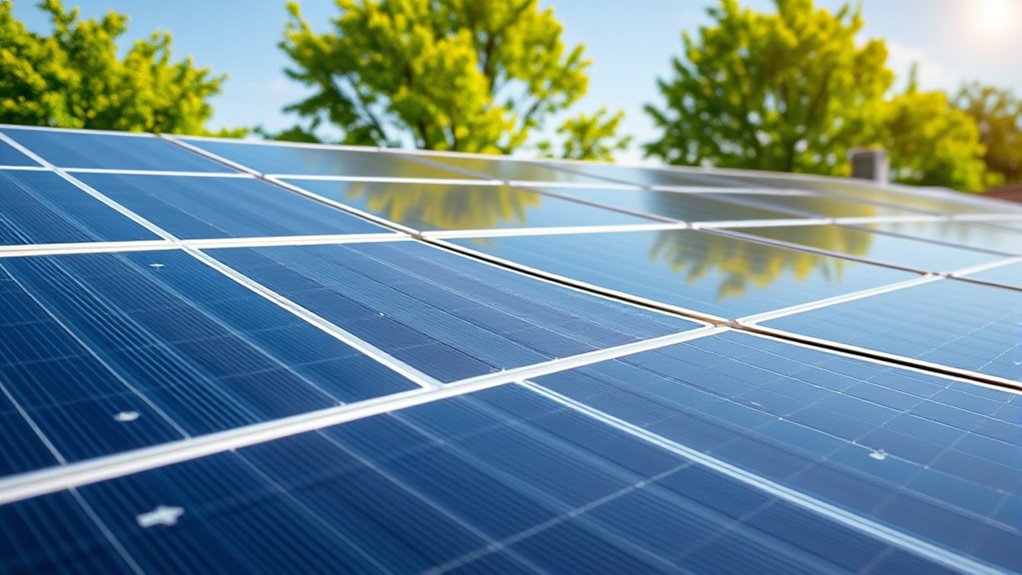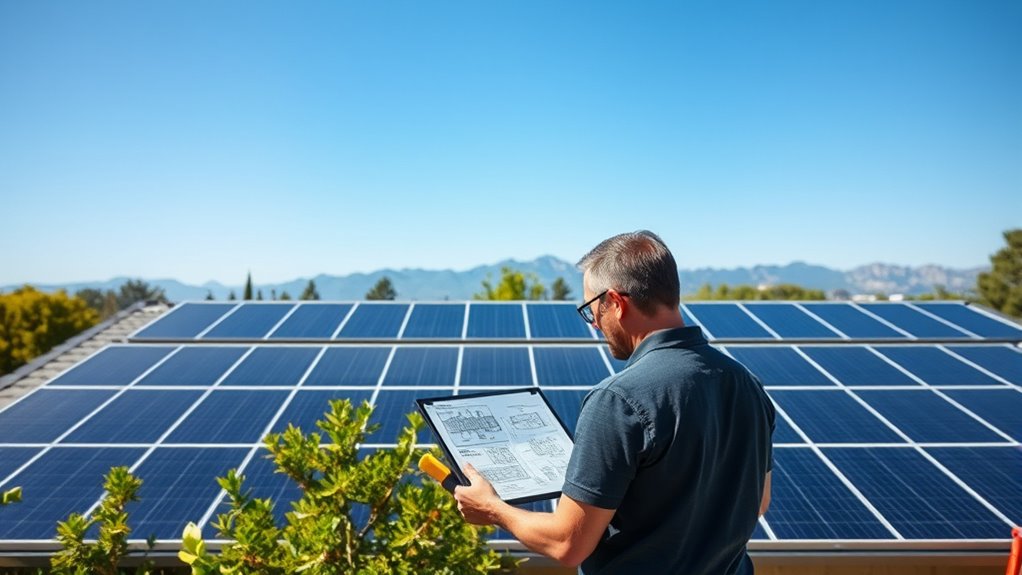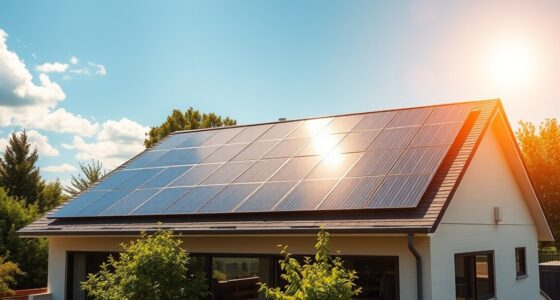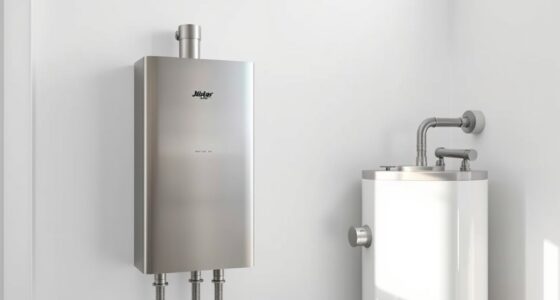To choose the right solar panels, consider your budget, available space, and energy needs. Monocrystalline panels offer higher efficiency and sleek looks but cost more upfront, while polycrystalline options save money but require more space. If your roof isn’t ideal or you want flexibility, thin-film panels might work, though they’re less durable. Advanced tech like PERC, HJT, or TOPCon can boost lifespan and performance. Keep these factors in mind to find the best fit for your home’s goals.
Key Takeaways
- Assess your available space and energy needs to determine the most suitable panel type and size.
- Consider efficiency ratings; higher efficiency panels like monocrystalline generate more power in less space.
- Balance upfront costs against long-term savings, factoring in panel lifespan and warranty coverage.
- Evaluate climate conditions; advanced tech like HJT or TOPCon perform better in hot or variable temperatures.
- Choose panels that match your aesthetic preferences and roof characteristics for optimal performance and appearance.

Choosing Solar Panels
Choosing the right solar panels for your home can substantially impact your energy savings and overall satisfaction. You need to take into account several factors, including the type of panel, efficiency, cost, durability, space requirements, and aesthetics. Each type offers distinct advantages and disadvantages, so understanding these differences helps you make an informed decision tailored to your needs.
Selecting the right solar panels affects savings, durability, and aesthetics—consider efficiency, cost, space, and style for optimal results.
There are four main types of solar panels: monocrystalline, polycrystalline, PERC, and thin-film. Monocrystalline panels are made from high-quality silicon, giving them a sleek black appearance and the highest efficiency among residential options—up to around 24.3%. They produce more power per square foot, making them ideal if space is limited or you want a cleaner, uniform look. Polycrystalline panels, on the other hand, have a bluish, fragmented look and use lower-quality silicon. They’re generally more affordable but require more roof space to generate the same energy, which might be a concern if your roof isn’t large.
Thin-film panels are lightweight and flexible, allowing installation on non-traditional surfaces. However, they tend to be less efficient, often requiring considerably more space to meet your energy needs, and they generally have shorter lifespans. If you’re looking for a cost-effective option and have ample space, thin-film might seem attractive, but their lower durability makes them less suitable for long-term residential use. PERC technology, integrated into some panels, enhances efficiency within traditional types, helping you get more power from each panel and improving overall performance, especially at higher temperatures.
Efficiency and performance are key considerations. Monocrystalline panels top the chart, offering the highest power output, which means you can generate more energy with fewer panels. Polycrystalline panels are less efficient but still viable if you have plenty of space or are on a tighter budget. Newer technologies like heterojunction (HJT), TOPCon, and IBC cells further improve efficiency and reduce power loss, particularly in hotter climates, expanding your options.
Cost plays a major role. Monocrystalline panels generally carry a higher upfront price due to their manufacturing process and material quality, but their longer lifespan and higher efficiency can lead to better savings over time. Polycrystalline panels are more affordable but offer slightly lower performance. Thin-film panels are the cheapest initially, but their durability and lower efficiency often offset their low cost. You should balance your budget against your long-term energy goals, considering that investing in higher-efficiency panels can save money in the long run.
Durability and lifespan also matter. Monocrystalline panels tend to last longer and come with better warranties, making them a reliable choice for most homeowners. Polycrystalline panels are decent but may need replacement sooner, while thin-film options usually don’t last as long or withstand harsh conditions as well. The technology advancements like heterojunction cells contribute to longer-lasting panels that maintain performance over time. Additionally, understanding the importance of panel efficiency can help you select options that maximize your energy output relative to your roof space.
Finally, take into account your roof space and aesthetics. Monocrystalline panels are more space-efficient and have a uniform black look, which many homeowners prefer for a clean appearance. Polycrystalline panels have a speckled blue style that some find less attractive. Your roof’s size, orientation, and shading will influence which type fits best, ensuring you maximize energy production without sacrificing aesthetics.
Frequently Asked Questions
What Is the Lifespan of Different Types of Solar Panels?
You wonder about the lifespan of different solar panels. Monocrystalline and polycrystalline panels typically last 25-30 years, though monocrystalline ones tend to degrade less over time. Thin-film panels usually have a shorter lifespan and lower efficiency, around 7-9%. Your panels’ durability depends on installation quality, maintenance, and environmental factors. Investing in high-quality equipment and proper upkeep can maximize your panels’ longevity and performance over their lifespan.
How Do I Compare Solar Panel Efficiency Ratings Accurately?
They say “you get what you pay for,” and comparing solar panel efficiency ratings proves that. To do it accurately, look beyond the efficiency percentage; check if it’s measured under standard test conditions, and compare both theoretical and actual efficiencies. Consider the panel’s brand reputation, warranty, and performance in your climate. This way, you’ll see which panel truly offers the best value for your energy needs.
Are There Specific Panels Better for Cloudy Climates?
Since you’re considering panels for cloudy climates, look for high-efficiency options like monocrystalline, HJT, or IBC panels. These perform better in low-light conditions, converting more sunlight into energy. Brands like Panasonic, REC, Maxeon, Longi, and Trina offer models suited for cloudy weather. Remember, investing in durable panels with good warranties guarantees consistent performance and long-term savings, even when sunlight is limited.
What Are the Maintenance Requirements for Various Solar Panels?
You’ll want to understand the maintenance needs of different solar panels to keep them performing well. Typically, clean them two to four times a year using a soft brush and gentle cleaner from the ground. Monocrystalline and polycrystalline panels require minimal upkeep, while thin-film types might need more frequent cleaning. Regular inspections for debris, damage, or animal activity help make sure your system stays efficient and lasts longer.
How Do Warranties Differ Between Solar Panel Brands?
You’ll notice warranties differ among solar panel brands in key ways. Some, like Panasonic and REC, offer 20-25 year warranties with performance guarantees, while Solar Insure provides a 30-year all-inclusive coverage. Pay attention to product, performance, and labor warranties, as well as transferability and degradation rates. Longer warranties and lower degradation rates give you better peace of mind and protect your investment over time.
Conclusion
Now that you know what to look for, isn’t it time to make the switch to solar? Choosing the right panels can save you money and reduce your carbon footprint, so don’t settle for less. Think about your energy needs, budget, and the panel’s efficiency—are you ready to take the next step toward a greener home? With the right choice, you’ll enjoy clean energy for years to come. Why wait to start harnessing the sun’s power?









